Someone from our crew made the commendable but all-too-rare admission that he didn't understand something; in this case, the catch. So I thought I'd write about it.
[Next day update: having written far too many words, I find I need more. Firstly,
British Rowing has some pix and text which you
might find helpful, but quite likely won't. Ditto
RowPerfect. Secondly, although there are lots of words here they should all fit together; they shouldn't be hard to remember, though they may be hard to apply. Thirdly, you could consider this a (self-)coaching resource rather than instruction. By which I mean, after you've been shouted at by your coach for incomprehensible reasons, come back here and read the appropriate bit to learn what they meant. Also, its useful to self-coach, if you know what you're aiming for.
2018 update: having seen something - but which I cannot find right now - I now think the stuff about straight lines, below, is even more idealised than I thought when I wrote it. Nonetheless, as with other things, it is probably good to
think in terms of straight lines.]
Context
I begin by placing the catch into its context within the rowing stroke. The stroke is a cycle with no beginning or end so we need an arbitrary start point; we could use the catch but we usually use the finish; the clue is in the name, perhaps.
At the finish you have just pulled your blade through to its reference point nicely square; you tap down cleanly, extracting the blade square momentarily, and push your hands away smartly (but not too fast) feathering the blade smoothly. In the idealised version of the stroke your arms are straight before your body starts to rock over (but in the real world it isn't; watch for example the
Krauts winning the 2012 Olympics at 13:40 and you'll see I'm right; its more a concept to think of than a thing to actually aim for; do not be surprised if your coach would rather you didn't say that); your body rocks over, your legs break and you start moving up the slide, initially fast following your hands. Its helpful, I think, to think of yourself following your hands - you definitely don't want to think of pulling yourself up the slide with your legs. And as you come towards the catch - see, we're getting there at last - your body remains rocked over to the angle you set at the beginning of the recovery, your shoulders twist round somewhat (so that they remain roughly parallel to the blade in its arc; of course this isn't a sudden twist just before the catch; but see-also "shoulders", below), your hands raise to bring the blade down towards the water, and you decelerate your forwards motion. Instantaneously you are stationary, as you transition from forwards to backwards motion, but you don't want to think of it like that - more on that later; we're still in the context section. Your hands raise - but your shoulders don't move - to put the blade in the water, it engages, and you begin the leg drive - with a straight outside arm and with your core braced enabling you to hold the back angle, though of course it begins to rotate about your spine's axis - and we're onto the drive phase, which is another post.
The catch position is dynamic: you have compressed your legs, your shins are vertical, your chest is touching your inside knee (think of it that way round), your shoulders are rotated. Staying, statically, in this posture is difficult and unpleasant, and/or impossible.
A picture
...takes the bandwidth of a thousand words. But can be useful. In the unlikely event that you're not from our club and you're reading this, it also gives you some hint of the
level we're rowing at. I'm at 6, if you care.

This is on the tideway, but on a good day; we're all (cough) bringing our blades down to the water nicely square. Note also the separation of our heads as we arc around our riggers.
Common errors
Before discussing the subtleties of getting it right, it may be helpful to look at some common errors, by way of contrast.
Hanging at the catch
There is often a distinct pause, delay, or insufferable slowness. Perhaps because you're rushed up the slide ahead of your stroke and now have to wait, but its also fairly common in strokes, too, who get no corresponding excuse. Its bad. Don't do it. The thing I've had said to me, and that I say to people, is that if you get to the catch early just go in anyway, but adjust your timing on the next recovery so you're less early. And so on, iteratively. Getting into the habit of hanging is hard to shake.
But why is it bad? Well, its a waste of time and gets in the way of high ratings. Its also hard to get the exact timing right at high ratings. More subtlely, its bad for the boat run (in terms of weight acceleration and deceleration, thus balance of forces), though I'd have a hard time justifying that if you pushed me. But also because of the noted-above "catch position is dynamic": if you hang at the catch you'll inevitably start unwinding your compression, which means you'll lose some potential drive.
Rowing in
Which leads on to rowing in. Ideally, you'll put the blade in, quickly, at the front-point of your movement, and start applying power the moment its in, thus making the most of your potential drive from the compression of you legs. Look back at the Germans, or any Olympic crew, and you'll see this, though its hard to see because its so fast (if its not obvious: because from the moment your blade is enough in the water to be moving with it, till the point at which its fully buried and you can usefully push, it must be moving with the water, losing you compression. How much you lose is proportional to how long the insertion takes; so, the quicker the better). If your catch is fairly slow, or if - as is common - you start the leg drive before the blade is fully buried(or even while its still in the air, this too is common) - you can lose a significant fraction of the drive. In the lower divisions, people are often effectively rowing at half slide, they're losing so much.
The inverse of rowing in is backsplash; see below.
Skying at the catch
Often leads to rowing in. If your blade is way up in the air, there's not much hope its going to make it into the water before you start your leg drive. Nor much hope that you'll be in time with anyone else.
Feathering in / not squaring early
At the catch - indeed, somewhat before it, exactly how soon before is a matter for crew preference - your blade must be square. So it can just drop in(but see "backsplash", below). If you have to finish squaring it when you're supposed to be taking the catch, you'll (a) be late and (b) miss water, leading to rowing it in, see above.
Beware the common coaching situation where people are squaring late, as they often do. The coach will say "square as the blade comes over your knees" or "square as it goes over your ankles". What they mean is "square earlier you bastards", they don't really intend you to take them literally Except for the silly ones who have had the same thing shouted at them, and they've failed to think about it.
Doing anything at the catch other than dropping the blade in
The culmination of all these errors is that at the catch,
all you should be doing is dropping the blade in. If you've left yourself anything else to do - finishing squaring, lurching, jerking, grabbing some extra reach - then you'll get distracted and out of time and things will go wrong.
Bumshoving
This used to be very popular, but I don't see it much nowadays. It will occur if you fail to hold your core whilst driving with the legs, leading to your arse going backwards faster than the blade handle, and thus the angle you're rocked over to increasing. The inverse of this is the more common fault of taking the catch at least in part with your back, rather than your legs. Do neither: keep the back angle constant at the catch.
Blade height and handle height approaching the catch
The blade is rigid, so talking about blade height is the same thing as talking about handle height. But it often confuses people. Frequently, when coxing, and seeing people skying, I say "raise your hands into the catch" and people do the precise opposite, raising the blade and lowering their hands.
I think I have to acknowledge that there are two different styles of handle-height on the recovery and into the catch, which I shall call the "swoosh"(S) and the "one direction" (OD). Neither is "correct"; but everyone in a given boat should do the same thing. I far prefer OD. S may be fine for Olympians; for common folk it leads to dreadful skying.
Let me cover that and explain why, before going on to the One True Way. If you "swoosh" then you do a fairly small (energy efficient!) tap-down; your blade doesn't much clear the water as you come forwards, so much so that as you come to square the blade you need to lower your hands to raise the blade shaft so the blade has room to be square. So coming into the catch the blade swooshes up, squares, then comes down into the water. Fine, if you're Olympian. In common folk this routinely turns into a far-too-big swoosh, a big enticing circular motion that
feels alluringly fine but is actually slow, and the blade goes waaay too high in the air; skying, per the above errors section.
I prefer One Direction: you tap down enough that there's room to square the blade without adjusting your hand height. As you approach the catch your hand height varies in only one direction, viz, it raises as you square, thus bringing the lower edge of the blade down to just-above the water. What you think about is not the height of the shaft, but the height above the water of the lower edge of your in-the-process-of-squaring blade.
Quite how far you take this depends on how sat your boat is, amongst other things. See-also backsplash, below. The exact time / phase at which you start raising your hands, and the phasing of that with respect to squaring, are also variable-but-everyone-in-the-boat-should-do-the-same.
Hand height during the stroke is composed, mostly, of straight lines not curves. This is important. During the drive phase, obviously, your hand height should be constant, at the height that results in your spoon being buried but the shaft not. During most of the recovery, your hand height is constant, perhaps at 2 inches above the saxboard, or whatever your crew has agreed on. Connecting those, at the finish, you have a largely vertical tap-down, obviously with rounded edges merging with the drive and recovery heights. Connecting recovery to catch your hands will rise gently smoothly in a curve, until the moment you lift them sharply to put the blade in.
Backsplash
Caius are the masters of this, in a good year (see
for example 2012, though arguably they took it a bit far). Or so I observe.
Rowing in motion has a page about it, which is worth a look, and it also (inevitably) covers the inverse, rowing-in.
The idea is that whilst the
ideal has you simply dropping the blade in, this is incredibly difficult in practice. And the best practical way to approach the ideal is to put the blade in the water while your hands are still moving forwards. Inevitably, this pushes some water the other way, which you see as backsplash. Doing this takes some getting used to - your muscle reflexes are likely tuned to keep the blade off the water until you're fully at frontstops; you'll have to fight against it. But once you are used to it - I find - it provides a helpful trigger for now-its-time-to-push (push, not pull, because its your legs working at the catch phase, not your arms).
Dropping the blade in
As a rough rule of thumb,
you can't get the blade in quicker than gravity could, unassisted by your muscles. Notice the italicised "you": Olympians can, but anyone reading this blog and learning from it probably can't. This is one reaaon why its helpful to think of just dropping the blade in, not forcing it in. If you're so stiff you're forcing it in, you'll probably go too deep - digging. And you'll be slower than gravity as well - your muscles are probably slowing it down, not speeding it up.
Shoulders
"loose shoulders" is the cry of all the coaches. Which can only be understood as the inverse of "stiff shoulders". At the catch, the lower edge of your blade is travelling through a delicate arc, guided by your hands on the other end of the blade. This can't work if your hands, arms and shoulders are all locked as a rigid unit, with the blade height then guided by the angle of your torso. The motor control just isn't fine enough for the torso. So you need to have the shoulder joint - the one for the outside arm is the one you want to think about - loose and unlocked, your hand hardly gripping the blade until the drive kicks in.
Its a commonplace to assert that the shoulders should be roughly parallel to the handle. I said it above, so it must be true. But it isn't, quite. You want the shoulders parallel, when looking from above, in terms of twist around the arc of the blade. But strictly parallel would also imply that the outside shoulder was higher than the inside. It doesn't have to be, Don't believe me? Well,
Caius don't do it, and they're better than you or me (that also throws up the thorny question of how far should you reach? That's another post).
There's a suggestion (see
for example here) that the reason people are taught to keep the outside shoulder high is that, if you've locked shoulder and arm, dropping the shoulder will raise the blade, and that's bad. But if you're wise enough to follow the first paragraph of this section, you can ignore the "outside shoulder should be higher" stuff.
Epilogue
There's a quite-decent video a stick man through the whole stroke at
https://www.youtube.com/watch?v=UXnKyJdA01w.
I say quite decent because there's one or two bits of bollox in it:
* "arm draw must take advantage of momentum from leg drive"- I know what you're trying to say but its wrong; there's no momentum there to take advantage of. What they're trying to say is that the arm (and before it the back) needs to blend seamlessly into the leg drive.
* flat wrists: meh, not bollox, but not essential: you get a choice between keeping your arm moderately tucked in, or your wrist flat, both are desireable, you can't do both (in the boat; less sure about on the erg).
* "lunging kills set and power" - no, not really. Its just very hard to get everyone in time if you do that.
* 70% of power form leg drive - and yet, other sources give different numbers.
* drop inside shoulder at the catch - see above.

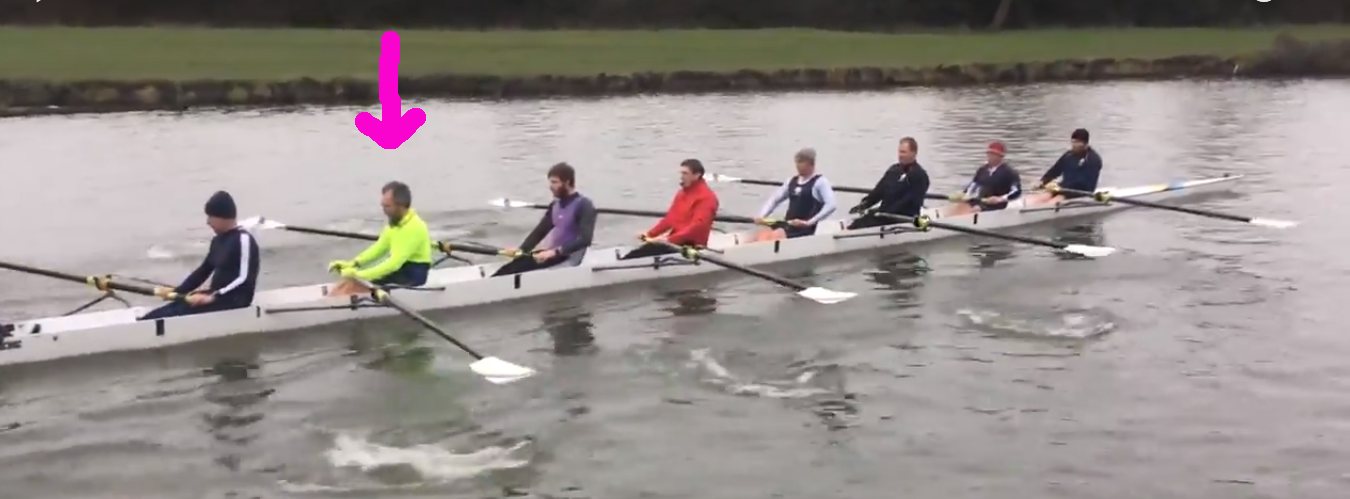
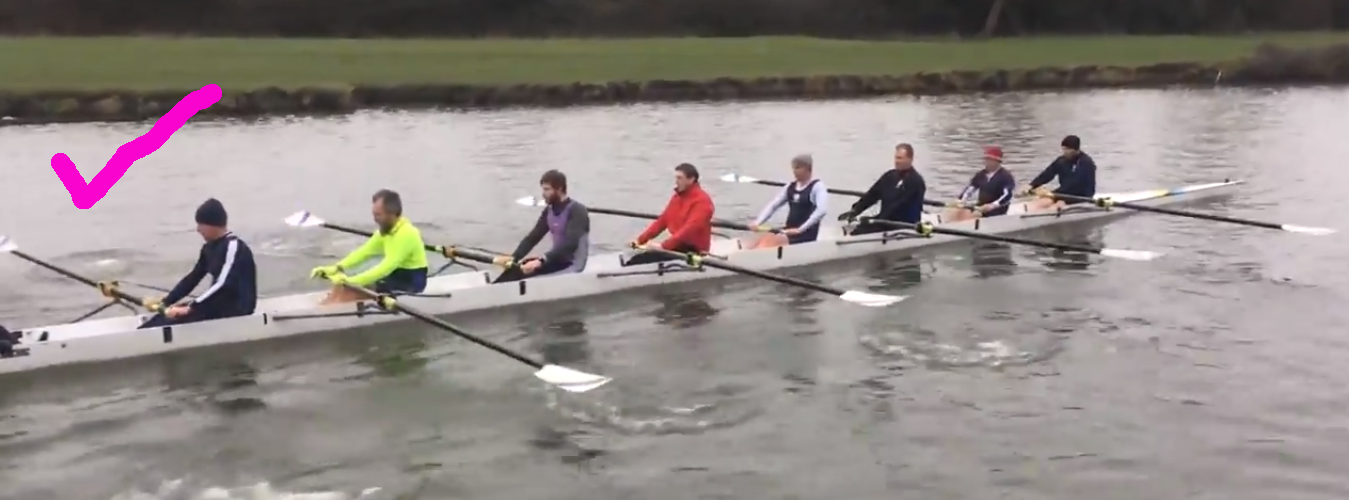
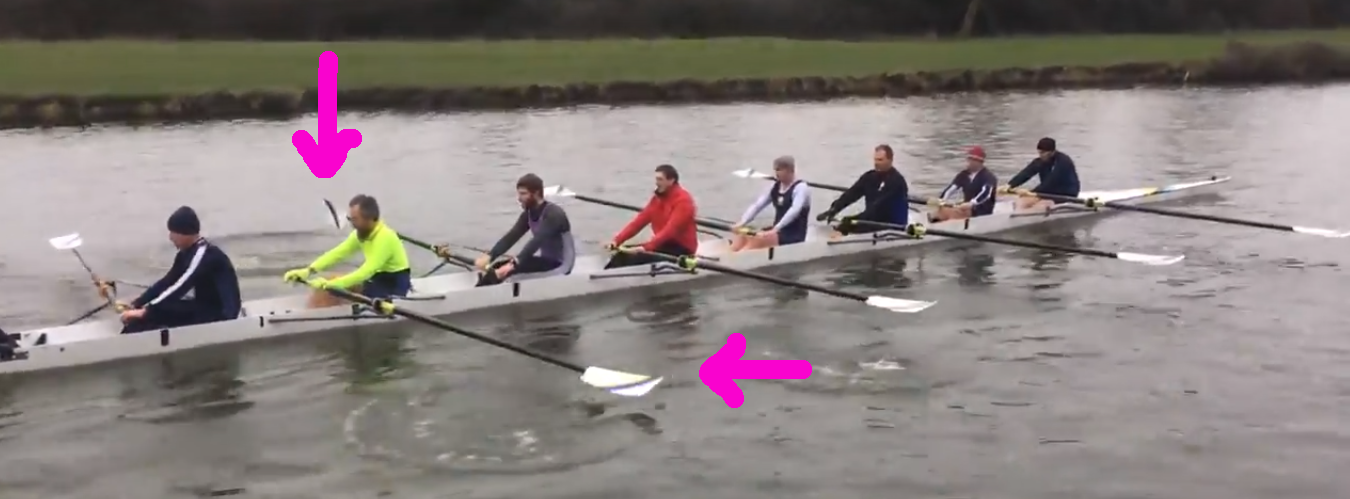


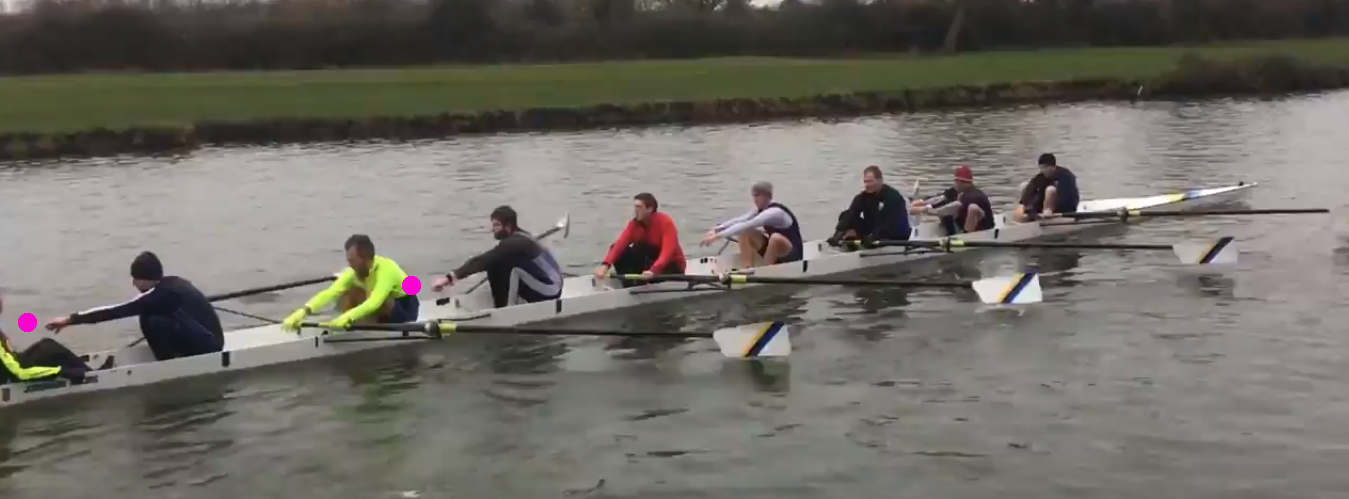


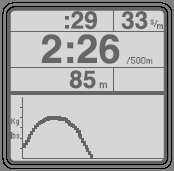 Lets begin by looking at force curves on the erg, because we need some context. As you might expect, C2 have
Lets begin by looking at force curves on the erg, because we need some context. As you might expect, C2 have